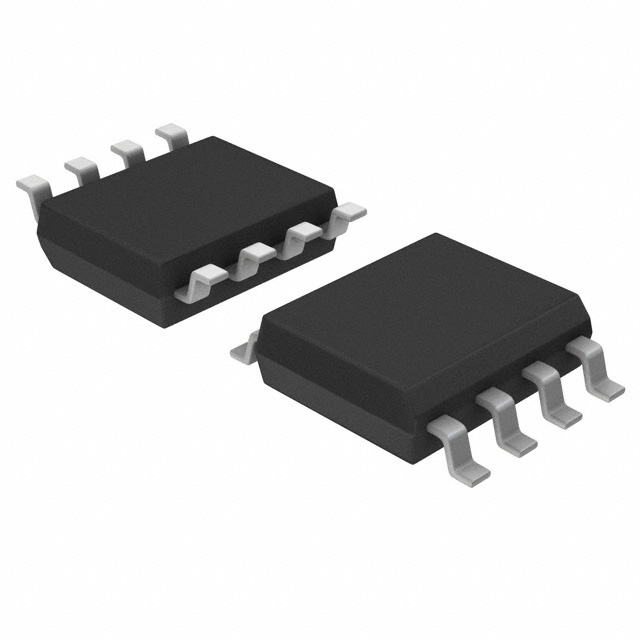Consulte las especificaciones para obtener detalles del producto.

TLC072IDR
Product Overview
- Category: Integrated Circuit (IC)
- Use: Operational Amplifier
- Characteristics: Dual, Low Power, Rail-to-Rail Input/Output
- Package: SOIC (Small Outline Integrated Circuit)
- Essence: The TLC072IDR is a dual operational amplifier designed for low power applications. It offers rail-to-rail input and output capabilities, making it suitable for use in a wide range of electronic circuits.
- Packaging/Quantity: The TLC072IDR is available in a standard SOIC package. Each package contains one IC.
Specifications
- Supply Voltage: 2.7V to 12V
- Input Offset Voltage: ±1mV (maximum)
- Input Bias Current: ±0.5pA (typical)
- Gain Bandwidth Product: 3MHz (typical)
- Slew Rate: 2.3V/µs (typical)
- Operating Temperature Range: -40°C to +125°C
Detailed Pin Configuration
The TLC072IDR has a total of 8 pins. The pin configuration is as follows:
- Non-Inverting Input (Op-Amp A)
- Inverting Input (Op-Amp A)
- V-
- V+
- Output (Op-Amp A)
- Non-Inverting Input (Op-Amp B)
- Inverting Input (Op-Amp B)
- Output (Op-Amp B)
Functional Features
- Low power consumption: The TLC072IDR operates at a low supply voltage and consumes minimal power, making it ideal for battery-powered applications.
- Rail-to-rail input/output: The operational amplifier can accept input signals that extend from the negative supply voltage to the positive supply voltage, and its output can swing from the negative supply voltage to the positive supply voltage.
- Wide operating temperature range: The TLC072IDR can operate in extreme temperature conditions, ranging from -40°C to +125°C.
Advantages and Disadvantages
Advantages: - Low power consumption - Rail-to-rail input/output - Wide operating temperature range - Dual operational amplifier configuration allows for more versatile circuit designs
Disadvantages: - Limited gain bandwidth product compared to some other operational amplifiers - Higher input offset voltage compared to precision operational amplifiers
Working Principles
The TLC072IDR is based on a CMOS (Complementary Metal-Oxide-Semiconductor) technology. It utilizes a differential amplifier at its core to amplify the voltage difference between the non-inverting and inverting inputs. The rail-to-rail input/output capability is achieved through the use of specialized input and output stages that allow the amplifier to operate with minimal distortion even when the input or output signals approach the supply voltage rails.
Detailed Application Field Plans
The TLC072IDR can be used in various applications, including but not limited to:
- Battery-powered devices: Due to its low power consumption, the TLC072IDR is suitable for use in portable electronic devices such as handheld meters, sensors, and medical instruments.
- Audio amplification: The rail-to-rail input/output capability makes it well-suited for audio amplification circuits, where it can handle both small and large amplitude signals without distortion.
- Signal conditioning: The operational amplifier can be used for signal conditioning tasks, such as amplifying weak sensor signals or filtering out unwanted noise.
Detailed and Complete Alternative Models
- LM358: Dual operational amplifier with similar characteristics and package options.
- MCP602: Low-power dual operational amplifier with rail-to-rail input/output capabilities.
- TLV2462: Precision operational amplifier with low input offset voltage and rail-to-rail input/output.
These alternative models offer similar functionality to the TLC072IDR and can be considered as alternatives based on specific application requirements.
Word count: 409 words
Enumere 10 preguntas y respuestas comunes relacionadas con la aplicación de TLC072IDR en soluciones técnicas
What is the operating voltage range of TLC072IDR?
- The operating voltage range of TLC072IDR is 4V to 44V.Can TLC072IDR be used in low-power applications?
- Yes, TLC072IDR is suitable for low-power applications due to its low quiescent current.What is the typical input offset voltage of TLC072IDR?
- The typical input offset voltage of TLC072IDR is 150µV.Is TLC072IDR a dual operational amplifier?
- Yes, TLC072IDR is a dual operational amplifier with two independent op-amps in a single package.What is the unity-gain bandwidth of TLC072IDR?
- The unity-gain bandwidth of TLC072IDR is 3MHz.Can TLC072IDR operate in extended temperature ranges?
- Yes, TLC072IDR is designed to operate in extended temperature ranges from -40°C to 125°C.Does TLC072IDR have built-in EMI filtering?
- Yes, TLC072IDR features built-in EMI filtering to reduce electromagnetic interference.What is the input common-mode voltage range of TLC072IDR?
- The input common-mode voltage range of TLC072IDR extends from the negative supply rail to within 1.5V of the positive supply rail.Can TLC072IDR be used in precision instrumentation applications?
- Yes, TLC072IDR is suitable for precision instrumentation applications due to its low input bias current and offset voltage.What is the recommended decoupling capacitor value for TLC072IDR?
- It is recommended to use a 0.1µF ceramic capacitor placed close to the power supply pins of TLC072IDR for proper decoupling.

